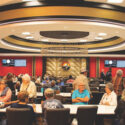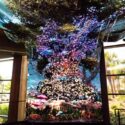
Before the Mirage opened in 1989, the heights of culture inside a casino were often portraits of dogs playing poker. The thought of filling the walls of a casino hotel with fine art was something that was unimaginable in gaming’s early years.
Enter Steve Wynn. His Golden Nugget properties in Las Vegas and Atlantic City were elegant and sophisticated (for their time), but his idea for casino art was scattering 31 gold nuggets around the casino to astound visitors. But the seed was planted.
It wasn’t until he began planning the Mirage that the idea of fine art inside a casino came to the forefront. In fact, some experts believe Wynn’s design for the Mirage was inspired by Paul Gauguin’s South Pacific artwork. But even at the Mirage, the attractions were mainly visual and three-dimensional—the volcano that greeted visitors with its twice-hourly eruption; the dome that replicated a jungle setting; Siegfried and Roy’s white tigers; his Cirque du Soleil extravaganzas. And his next development, Treasure Island, was more of the same with the famed pirate ship battle out front.
Art didn’t really make its appearance until he began planning the Bellagio, itself a piece of architectural art with the dancing fountains along the Strip. His love for art became full blown when he created the Bellagio Gallery of Fine Art, along with the Picasso restaurant where you could eat amid authentic Picasso masterpieces, and a view of the Bellagio Fountains. Picasso’s Chef Julian Serrano created food that looked and tasted like fine art. Wynn brought to his casino audience the enchantment of Renoir and Monet, the delicacy of Degas, and inspiring vibrancy of Warhol.
His final casino creation, Wynn and Encore Las Vegas, continued his love for art. In fact, the original name for the Wynn property was to be “Le Réve” after the famous Picasso painting. Visitors to those properties could view the $23.5 million dollar Renoir titled “In The Roses,” and Jeff Koons’ striking sculpture, “Tulips,” not to mention his whimsical “Popeye” sculpture.
Now that his time as a casino operator is over, Wynn continues to be a major art collector. His Wynn Fine Art Galleries in Palm Beach and Beverly Hills allow showings by appointment only, and his fine art career continues.
Corporate Influence
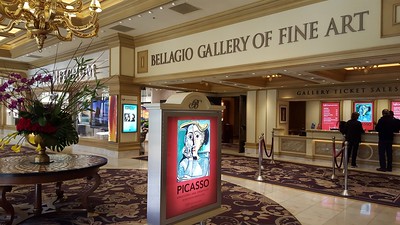 But Wynn’s influence on gaming continues to this day, and fine art is now almost a prerequisite of a quality casino development.
But Wynn’s influence on gaming continues to this day, and fine art is now almost a prerequisite of a quality casino development.
When he sold his Mirage Resorts properties, including the Bellagio, to MGM Resorts in 2000, the concept of fine art and gaming did not go away. MGM has maintained, and some say even improved the quality of the Bellagio Gallery of Fine Art.
Demecina Beehn is MGM’s curator and manager of the company’s art collection, which extends far beyond the Bellagio. She says MGM recognized the value of the Bellagio gallery immediately.
“We are an entertainment company in addition to shows, dining and hospitality we offer,” she says. “Art is part of the overall experience. Through our efforts, we make public art accessible to 40 million-plus visitors who come to Las Vegas each year. MGM Resorts’ fine art collection is a living organism, and has evolved many times over the decades, showcasing a multitude of mediums. We are most focused on keeping diversity, equity, and inclusion at the core of our collecting practices and the guest experience.
“Through our strong commitment to art, we have a unique position to elevate and further the work of historically underrepresented artists and communities. We have always believed that offering a public platform for art helps to expose audiences to new artistic encounters that may otherwise be inaccessible for our guests and community. So we are honored to work with artists from a variety of backgrounds to bring new life to our properties and expose our visitors to beauty and culture.”
While some galleries sell the pieces they display, Beehn says that isn’t always the case at the Bellagio gallery.
“We bring rotating exhibitions that are museum-quality,” she says. “We partner with museums, galleries, and private institutions to bring unique exhibitions to Las Vegas. It is an intimate two-room gallery, but we are really the only exhibiting space in Las Vegas that can bring the quality of exhibitions that we bring. It’s very important that the gallery continues to exist and continues to reach to a wider and wider collector base across the country and around the world, so that we can bring new and exciting things to our community in Las Vegas.”
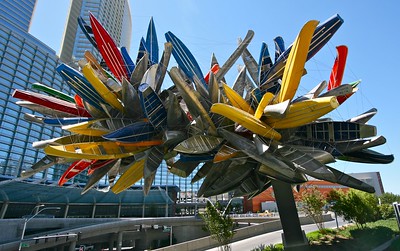
Nancy Rubins’ “Big Edge” at CityCenter
Fine art was emphasized at the opening of CityCenter and the Aria casino in 2009. With a series of art installations from sculptures to paintings, the development has become the center for arts in Las Vegas. And it transformed the way MGM considers the role of art in all its properties, says Beehn.
“The beauty of Aria and CityCenter was the moment where you see a pivotal shift in the way that we embedded art into our design,” she explains. “And it really became a pairing of art and architecture. So for instance, Maya Lin’s ‘Silver River’ sculpture behind the registration desk is a topographical representation of the Colorado River, which ends in Las Vegas. Embedding art and large-scale installations into the construction and design of a space has now become standard for us. So now when you go to some of our regional properties such as National Harbor in Maryland and MGM Springfield in Massachusetts, you will see site installations created specifically for that property as well as representations of the community.”
For CityCenter, Beehn says a committee evaluated the art and set some criteria for the selection of the pieces.
“We worked with art advisers and we had an executive committee that approved each work. We were really thinking of how we could showcase artists that were really of the time, and how we could bring works that were that were unique and not readily available.”
And it isn’t just the large gaming companies that focus on art. One of the most up-and-coming companies, Cordish Gaming, has made a place for all kinds of art.
For Suzi Cordish, the art in the Live! casinos built by the Cordish Companies and her husband, CEO David Cordish, is a labor of love.

Maya Lin’s elegant “Silver River” at Aria
“I was a collector before I even met David, and that was one of the ways we connected, because he was also a collector,” she says.
Even though Cordish had been a major developer years before it opened its first official casino with the Live! casino in Maryland, Suzi Cordish says there wasn’t a thought of using art in those places.
“They were mostly sports bars and venues where there were screens in every available space,” she says. “There really was no room for art, and even if there were it would not be appreciated.”
That changed at Maryland Live!
“That’s how it began,” she explains. “I had always acquired art for homes and residential spaces, so I had never really looked at something 20 feet in length and 10 feet high. But that was the scale I was looking at in the casino.
“I wanted to appeal to all of our guests and not just the gamblers. So we need pieces in the hotel space, and a lot of the artwork is in our entertainment venue—right before you go into some of the large music venues. Then there’s the reception areas. It’s not just for the gambler, but I do think that even the gamblers love seeing this new, exciting art.”
Like MGM Resorts, Cordish includes all sorts of art.
“I love sculpture and I love ceramics,” Cordish says, “so I am really an equal-opportunity collector in that respect. I love all the mediums. For sculpture, we have many examples, including a beautiful ‘cloud.’ It’s a grouping of nine steel shapes in our Maryland property signifying a cloud. We’re doing lots of different things besides just paintings on the wall.”
Both Cordish and Beehn have an appreciation for lesser-known artists, and enjoy giving them more exposure.
“While we have lots of well-known artists, we also have many emerging artists,” Cordish says. “We’ve got one gentleman based in Baltimore who did this really beautiful mural on the wall. He’s in his 40s at this point, but still an emerging artist doing amazing murals.”
With MGM, Beehn says it’s a mission to give newer artists exposure.
“Through our strong commitment to art we have a unique opportunity to elevate and further the work of historically underrepresented artists and communities,” she says. “And we have always believed that offering a public platform for art helps to expose audiences to new artistic encounters that may otherwise be inaccessible for our guests and community. And so we are honored to work with artists from a variety of backgrounds to bring new life to our properties and expose our visitors to beauty and culture.”
Return on Investment

Suzi Cordish selects the artwork that enhances the Live! casinos operated by Cordish Gaming
Suzi Cordish jokes that when she proposes the purchase of a piece of art to the Cordish board, they often are hesitant, but in the end, she says, it adds to the value of the company.
“In this business, I do have to be very aware and mindful of our partners and those involved,” she says. “So I don’t just go on a buying spree. I’m really thinking what’s best for the casino, but I’m also very mindful of what we’re doing financially and how it benefits the casino.”
She says the Cordish art collection has increased markedly in value since it was launched more than 10 years ago, so it’s a positive for the company in the long run.
For MGM Resorts, an auction of 11 Picasso paintings owned by the company in October 2021 netted almost $110 million, nothing to sneeze at even for a large company like MGM. All the sales drew record high prices in the sale coordinated by the New York auction house Sotheby’s. It was the first time Sotheby’s held an auction outside of its New York headquarters.
“When we announced this unique collaboration with MGM Resorts a few months ago, there was an immediate buzz,” Sotheby’s Chairman Brooke Lampley says. “(The) tremendous results only underscore the singular nature of this event, and the importance of creating bespoke experiences that cater to furthering our commitment to existing clients, as well as opening doors for a whole new audience to engage with Sotheby’s. With such a gracious partner like MGM Resorts and a star artist like Picasso, it was an incredible experience to bring our signature Evening Sale experience on the road—and we look forward to exploring and experimenting with new ways to share the magic of a Sotheby’s Evening Sale.”
And because the auction was held at the Bellagio, it turned out to be something of a special event for the property.

Steve Wynn continued his art collection with Jeff Koons’ “Popeye” on display at Wynn Las Vegas upon opening. It can now be seen at Encore Boston Harbor.
“We are grateful to our partners at Sotheby’s for a successful collaboration and a tremendous event weekend,” says MGM Resorts Chief Hospitality Officer Ari Kastrati. “From the receptions to the special programs to the auction itself, together we delivered a weekend program that could only happen in Las Vegas and only at MGM Resorts properties.”
The true value of presenting fine art to the communities where casinos operate is to elevate the status and respect of the companies. In Las Vegas, the Bellagio Gallery of Fine Arts is often a field trip for the area’s schoolchildren.
“Much like having the Conservatory at Bellagio or the fountains, being able to come to our property and walk around and be immersed in these things is a very unique experience for a lot of people,” Beehn says. “I remember even my first time staying at an MGM property, I was so surprised to find works by Richard Sara and Jasper Johns that the property actually became my staple property every time I visited Las Vegas.
“So I think that us having art helps to elevate the experiences of our community members and our status in the community. The schoolchildren that come to visit the gallery get to experience the exhibition that we have right now, which is Caldonia. It’s concert and film posters from the Ralph DeLuca collection. It’s a celebration of black performance history from the 1920s to the 1970s. And the fact that it’s free for school groups to view is a great asset to the community.”
Cordish says that’s definitely the case for her company’s hotels.
“It shows a sophistication and appreciation that is something that we can translate through the artwork without having to say that. But that’s a big part of what the arts can do—all the disciplines of the arts, including the music selection. Whether it’s music or other performing arts, or visual arts, I think they can enhance so much of a community experience and elevate the members of that community.”
The Artist’s Eye
Casino executive Michael Broderick has a special affinity for art
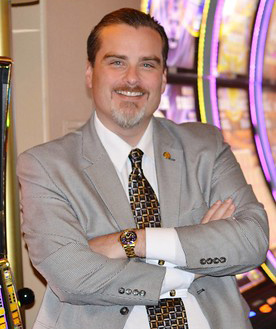 Michael Broderick (l.) is a proponent of the strategy that art can bring new and valuable customers to your casino. Broderick doesn’t run a casino owned by one of the major gaming companies and doesn’t work for a casino that is located near one of the major population centers. Now general manager of Northern Waters Casino Resort in Watersmeet, Michigan, which is owned by the Lac du Flambeau Band of Lake Superior Chippewa Indians, Broderick is known for his “out of the box” promotions at his previous jobs, including having players pan for gold or sending a slot machine into outer space. While those promotions were certainly unusual, Broderick insists they had a positive return on investment.
Michael Broderick (l.) is a proponent of the strategy that art can bring new and valuable customers to your casino. Broderick doesn’t run a casino owned by one of the major gaming companies and doesn’t work for a casino that is located near one of the major population centers. Now general manager of Northern Waters Casino Resort in Watersmeet, Michigan, which is owned by the Lac du Flambeau Band of Lake Superior Chippewa Indians, Broderick is known for his “out of the box” promotions at his previous jobs, including having players pan for gold or sending a slot machine into outer space. While those promotions were certainly unusual, Broderick insists they had a positive return on investment.
That’s why he does things a little differently than the larger casinos that use art almost like an architectural element rather than a moneymaker. He’s a student of the use of art for more than just pleasure—he tells a story about abstract artist Mark Rothko, who in 1958 received a commission to deliver 30 large-scale paintings to the new Four Seasons restaurant but was so annoyed that the diners barely looked at the paintings he returned the money and retrieved the paintings, a number of which today hang in the Tate Modern Museum in London.
“We look at art a number of ways,” he says about his property, “primarily as a new source of revenue, a tool for marketing and player development, and as a brand differentiator. Most importantly, it is a testament to the vision of our tribal council and board of directors under the leadership of our chairman. They had the vision and awareness to realize that we created something that will have an important and lasting legacy for the company and the tribe for generations to come. Art is multi-generational and can be immortal.”
Last year, the tribe and the casino management opened “The Contemporary,” the first wholly tribally owned contemporary art gallery in the country. The gallery allows local and national artists, including local indigenous artists, to highlight their work for a small fee and takes a commission on any sales of the paintings or objects on display. He says the revenue produced exceeded their expectations and plans to ramp up new artists and shows in the coming year.
Broderick says they also use art for special events, including exhibits by Banksy and Bob and Steve Ross, two wholly different varieties of artists.

Broderick’s portrait of Ernie Stevens
“Banksy is arguably one of the most well-known artists living today,” he says. “He transcends the exclusive ‘fine arts’ community, and is one of the rare examples of artists who have made their mark in popular culture. The same could be said about Steve and Bob Ross,” whose The Joy of Painting television program showed millions of Americans that anyone could paint.
That’s a lesson learned by Broderick, who in addition to being a talented casino executive, is an accomplished artist, whose works have been displayed at the Galen of the Palm Springs Art Museum, the Kalamazoo Institute of Art, the Muskegon Museum of Art and the Parrish Art Museum in Southampton, New York.
He says painting is an outlet for him, and while he’s appreciative when people give him positive comments on his art, he’d paint even if no one saw it.
“This has always been an important part of my life,” he says. “Professionally, it is incredibly cathartic and clarifying for me. Every day as leader-operators of these multimillion-dollar companies in this high-stress industry, we are faced with significant challenges and burdens that can cause serious harm to our health, both physically and mentally. This outlet allows me to remain centered and humble. Creating art, any art, is a very humbling exercise. So it grounds me too.”
Some of Broderick’s works are on display in the casino’s hotel—not for sale, however—and he recently completed a portrait of Indian Gaming Association Chairman Ernie Stevens (a Wisconsin native) that he presented to the tribal chairman, James Williams.
For other casinos, Broderick recognizes that using art might still be somewhat controversial, but if you’re creative, success will follow.
“Maybe the focus should be on other things rather than foot traffic or ticket sales,” he says. “Maybe it is justifiable and measurable as a tool for player development or art sales commissions. You just have to be creative about it and stay focused.
“You can show all the art you want for free! You don’t have to have a multimillion-dollar budget to acquire permanent works. There are so many artists, both good and bad, that desperately want the ability to show their work in a public space with high foot traffic. They will be overjoyed if you asked to borrow some of their works to display at the property. I know that if a property GM or tribal chairman approached me asking to borrow some of my work to dress up their space I would happily say yes.”



